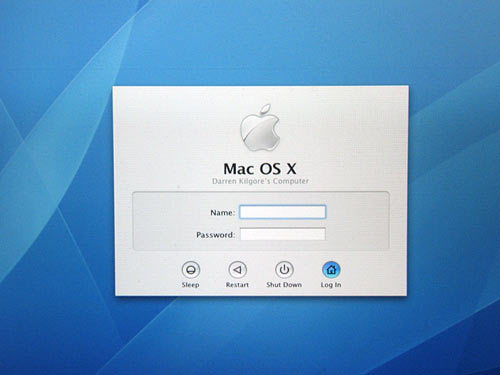Command–Brightness Down: Turn video mirroring on or off when your Mac is connected to more than one display. Option–Brightness Up: Open Displays preferences. This works with either Brightness key. Control–Brightness Up or Control–Brightness Down: Change the brightness of your external display, if supported by your display. G4's above 1GHz tend to be USB 2.0 late model G4 Macs that are only able to run Mac OS 9 in Classic Mode from an OS X installed system (unless user modified). I think that one exception to that rule is the G4 Mirrored Drive Doors (2003) 1.25GHz FireWire 400 model. Back up your Mac: This process will erase macOS High Sierra from your hard drive entirely. The full-scale dedicated store to download all the applications for your Macintosh system. This was released along with the Mac OS X leopard to get the response from the end-user about its practicality and when all positive reviews turned in, apple decided to go with the MacApp store with a tweak to the software frame and also improving the user interface between the user. MacBook Pro (15-inch, Late 2016), MacBook Pro (13-inch, Late 2016, Four Thunderbolt 3 Ports) 2. To use VoiceOver and VoiceOver Utility, you might need to turn on 'Use all F1, F2, etc. Keys as standard function keys' in Keyboard preferences.
Start up from macOS Recovery
Determine whether you're using a Mac with Apple silicon, then follow the appropriate steps:

Apple silicon
Turn on your Mac and continue to press and hold the power button until you see the startup options window. Click the gear icon labeled Options, then click Continue.
Intel processor
Make sure that your Mac has a connection to the internet. Then turn on your Mac and immediately press and hold Command (⌘)-R until you see an Apple logo or other image.
If you're asked to select a user you know the password for, select the user, click Next, then enter their administrator password.
Reinstall macOS
Select Reinstall macOS from the utilities window in macOS Recovery, then click Continue and follow the onscreen instructions.
Follow these guidelines during installation:
System Down Mac Os 11
- If the installer asks to unlock your disk, enter the password you use to log in to your Mac.
- If the installer doesn't see your disk, or it says that it can't install on your computer or volume, you might need to erase your disk first.
- If the installer offers you the choice between installing on Macintosh HD or Macintosh HD - Data, choose Macintosh HD.
- Allow installation to complete without putting your Mac to sleep or closing its lid. Your Mac might restart and show a progress bar several times, and the screen might be empty for minutes at a time.
After installation is complete, your Mac might restart to a setup assistant. If you're selling, trading in, or giving away your Mac, press Command-Q to quit the assistant without completing setup. Then click Shut Down. When the new owner starts up the Mac, they can use their own information to complete setup.
Other macOS installation options
When you install macOS from Recovery, you get the current version of the most recently installed macOS, with some exceptions:
System Down Mac Os Download
- On an Intel-based Mac: If you use Shift-Option-Command-R during startup, you're offered the macOS that came with your Mac, or the closest version still available. If you use Option-Command-R during startup, in most cases you're offered the latest macOS that is compatible with your Mac. Otherwise you're offered the macOS that came with your Mac, or the closest version still available.
- If the Mac logic board was just replaced, you may be offered only the latest macOS that is compatible with your Mac. If you just erased your entire startup disk, you may be offered only the macOS that came with your Mac, or the closest version still available.
You can also use these methods to install macOS, if the macOS is compatible with your Mac:
- Use the App Store to download and install the latest macOS.
- Use the App Store or a web browser to download and install an earlier macOS.
- Use a USB flash drive or other secondary volume to create a bootable installer.
Hello JEHAN1,
Thanks for that info and choosing the Apple Support Communities. I know that having an issue with System Preferences on your Mac not closing correctly is not what you expect!
If I understand correctly, you deleted a user on your Mac that is no longer being used. Then when you quit System Preferences, System Preferences stopped responding and will not close. The good news is you have a couple of options:
1. First, you can try to use the Force Quit option in the Apple logo menu to force System Preferences to Quit, then restart your Mac.
2. If you're still not able to get System Preferences to close, then shut down your Mac by choosing Shut Down from the Apple menu, or hold down the power button for up to 3 seconds until your Mac asks whether you're sure that you want to shut down your computer now.
3. If you can't shut down your Mac because it isn't responding, you can force it to turn off without shutting down. Hold down the power button for 5 seconds until your Mac turns off. Use this method only when you can't shut down.
You also may want to try starting up into Safe Mode to help resolve this, as Safe Mode performs certain system checks, deletes systems cache files, verifies your startup disk, and attempts to repair directory issues, if needed.
Cheers!
System Down Mac Os X
Jun 19, 2016 8:27 AM

